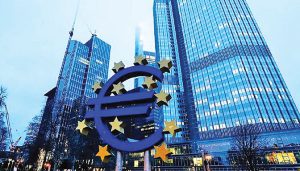Bloomberg
The European Central Bank’s (ECB) go-slow approach to starting interest-rate hikes is looking ever bolder at a time when most of its counterparts are tightening vigorously.
At the end of a week punctuated by global increases in borrowing costs to quell inflation, including an accelerated half-point move by the US Federal Reserve and the Bank of England’s fourth consecutive upward step, Frankfurt officials are far from following suit.
Aside from the Bank of Japan and the Swiss National Bank — each of whom are confronting far weaker inflation — the euro zone is now the only jurisdiction managing one of the so-called Group of 10 most-traded global currencies not to have raised rates.
That lone status crystallised in recent days after Australia delivered a first and larger-than-expected increase, and Riksbank completed a remarkable U-turn to suddenly hike itself.
While pre-existing pledges on timing are binding ECB officials into waiting, an economy long vulnerable to setbacks with a war raging next door and a threat of gas shutoffs looming is also giving them pause for thought.
Such is the steady poise euro-zone policy makers adopted that, despite first investor bets in over a decade that inflation in Europe could even out-pace that of the US, financial markets still reckon a rate move there is months away. That stance represents a relative triumph of guidance compared with the ECB’s struggles last year to persuade traders that its
policy wasn’t about to shift.
Going alone against the weight of global monetary opinion is likely to leave the central bank more exposed to scrutiny than before, not least when considering prior policy errors of abortive hikes in 2008 and 2011.
While ECB policy maker Robert Holzmann suggested that the Governing Council will discuss an increase at its June meeting, his colleagues have been more circumspect.
Some officials including Olli Rehn have coalesced around a move in July. Bank of France Governor Francois Villeroy de Galhau said that rates may be raised back above zero this year if the euro-zone economy doesn’t suffer another setback.
Meanwhile Executive Board member Fabio Panetta, one of the more dovish policy makers, even warned that the ECB faces “more complicated†choices at a time when expansion has almost stalled.
“Monetary tightening aimed at containing inflation would end up hampering growth that is already weakening,†he told Italy’s La Stampa newspaper.
As an Italian, he would know too that tightening would strain the country’s public finances. On Friday, the premium investors demand to hold Italian debt surged past two percentage points for the first time since May 2020 as markets braced for ECB stimulus removal.
Policy makers’ considered defense for their cautious stance is that the 19-nation economy is different from global peers. ECB President Christine Lagarde says that while both the US and Europe are confronting soaring prices, they’re also facing a “different beast.â€
Unlike in the US, inflation is driven predominantly by supply-side shocks; and unlike in the UK, fiscal stimulus is in place to offset cost pressures on consumers. Labour-market slack is higher, potential growth lower, and the war in Ukraine a bigger risk to the outlook than elsewhere.
But knock-on effects from stubbornly high inflation — 7.5% last month and rising — are starting to show nonetheless. Expectations among consumers, businesses and financial markets have climbed above the ECB’s 2% goal. Germany’s powerful IG Metall union seeking an 8.2% raise for steelworkers also shows that the threat of a wage-price spiral is real.
On the other hand, the economy faces the threat of recession, a potential outcome if gas flows from Russia are unexpectedly cut, prompting energy rationing.
Even without that risk materializing, the ECB’s window for action might be narrow. The economy started the year feebly and may slow further if strict coronavirus lockdowns in Asia and continued fighting in Ukraine choke strained supply chains, damp confidence and push inflation higher still.
Many economists predict the ECB will take its deposit rate — currently at a record-low -0.5% — to zero in two steps before pausing for a while to take stock and see how financial markets and the economy digest the exit from sub-zero territory after more than eight years.
Helping the ECB fight inflation are markets, which have started to tighten financing conditions all on their own. Bond yields have risen across the region, banks are stricter with credit standards, and loan growth to firms has slowed as a result.
“You’re going to get this flow through the financial system if the ECB is tightening or not,†said James Rossiter, head of global macro strategy at Toronto Dominion Bank. “Some of that work is happening, and that’s maybe why the ECB isn’t rushing into it.â€
Even so, the contrast between the ECB’s gradualism and the aggressive action seen in much of the world — one that the Fed acknowledges will mean “some pain†— is only likely to encourage future critiques of each approach.
“History will judge many central banks very harshly about this episode,†said Rossiter.
 The Gulf Time Newspaper One of the finest business newspapers in the UAE brought to you by our professional writers and editors.
The Gulf Time Newspaper One of the finest business newspapers in the UAE brought to you by our professional writers and editors.
